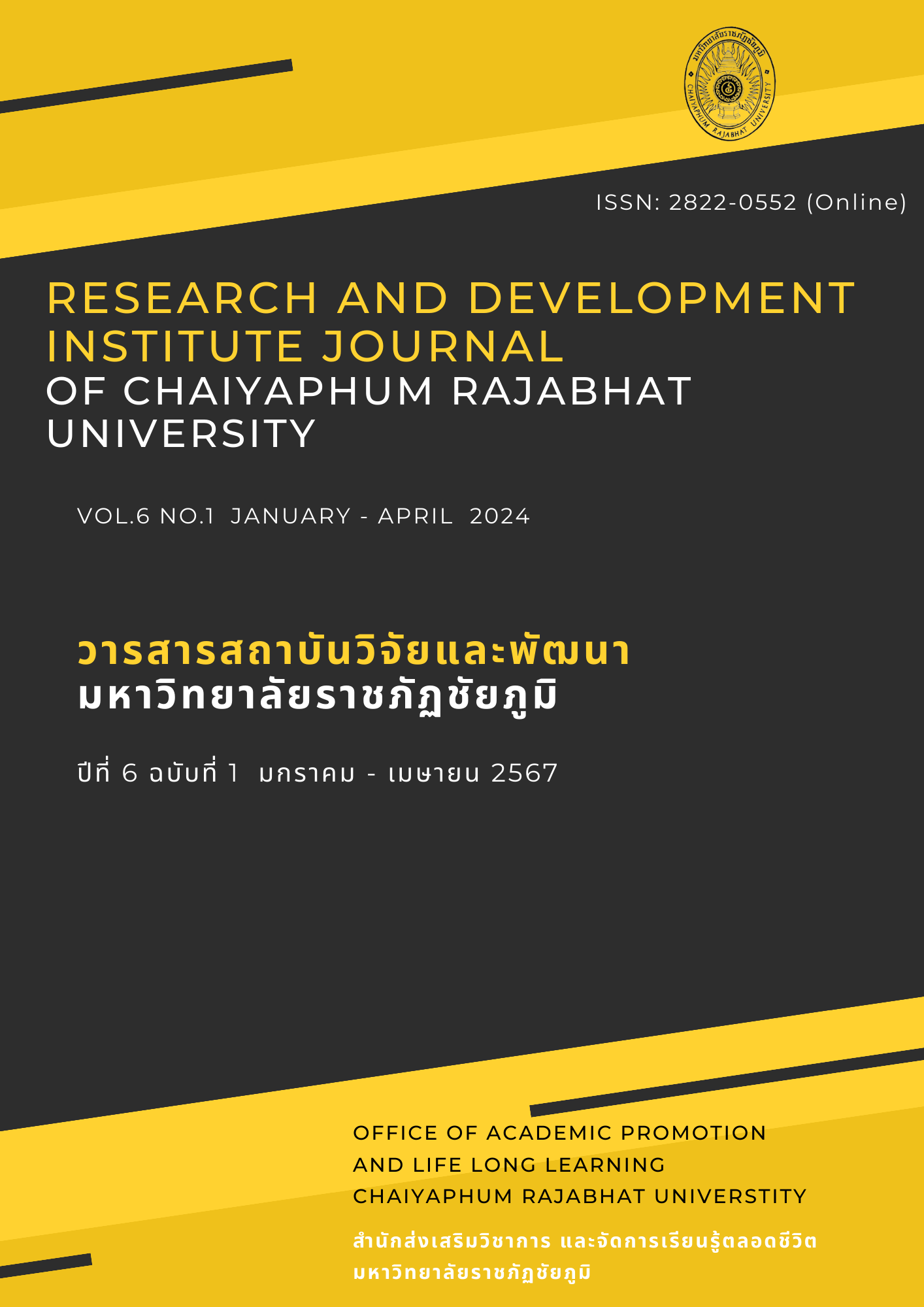A DEVELOPMENT OF BASIC JAPANESE LANGUAGE ONLINE LESSONS TO ENHANCE LISTENING AND SPEAKING SKILLS BASED-ON COMMUNICATIVE LANGUAGE TEACHING
Main Article Content
Abstract
The purposes of this study were to 1) develop basic Japanese language online lessons based on communicative language teaching of grade 2 students to find out its efficiency at, 80/80 criteria, 2) compare listening skills basic Japanese language online lessons based on communicative language teaching of grade 2 students for after learning with the 70 percent criterion and 3) compare speaking skills basic Japanese language online lessons based-on communicative language teaching of grade 2 students for after learning with the 70 percent criterion. The sample group for this research was 16 students of grade 2 students in the first academic year of 2022 at Pinnarin Wittaya School. which was selected by a simple random sampling method. The research instruments consisted of basic Japanese language online lessons based-on communicative language teaching and listening and speaking tests. The percentage, mean (), and standard deviation of items (S.D.) were used to analyze the data.
The research findings showed that: 1) the efficiency evaluation of basic Japanese language online lessons based on communicative language teaching of grade 2 students was E1 82.81 and E2 84.03 which was higher than the 80/80 criteria. 2) listening skills basic Japanese language online lessons based-on communicative language teaching of grade 2 students for after learning was higher than the 70 percent criteria with no statistically significant at .05 level. 3) speaking skills basic Japanese language online lessons based-on communicative language teaching of grade 2 students for after learning was higher than the 70 percent criteria with no statistically significance at the .05 level.
Article Details

This work is licensed under a Creative Commons Attribution-NonCommercial-NoDerivatives 4.0 International License.
Permission to use text, content, images, etc. of publication. Any user to read, download, copy, distribute, print, search, or link to the full texts of articles, crawl them for indexing, pass them as data to software, or use them for any other lawful purpose. But do not use it for commercial use or with the intent to benefit any business. Published under a Creative Commons Attribution-NonCommercial-NoDerivatives 4.0 International License.

This work is licensed under a Creative Commons Attribution-NonCommercial-NoDerivatives 4.0 International License
References
กระทรวงศึกษาธิการ. (2550). แนวทางปฏิรูปการศึกษาของกระทรวงศึกษาธิการ. กรุงเทพฯ: ที.เอส.บี. โปรดักส์.
กิติพงษ์ ลือนาม. (2561). วิธีวิทยาการวิจัยทางการศึกษา. นครราชสีมา: ห้างหุ้นส่วนจำกัด โคราช มาร์เก็ตติ้ง แอนด์ โปรดักชั่น.
จินตวีร์ คล้ายสังข์. (2554). หลักการออกแบบเว็บไซต์ทางการศึกษา: ทฤษฎีสู่การปฏิบัติ. กรุงเทพฯ : สยามการพิมพ์.
ทักษิณา วิไลลักษณ์. (2551). ออกแบบบทเรียน. คณะวิทยาศาสตร์และเทคโนโลยี มหาวิทยาลัยราชภัฎวไลอลงกรณ์ ในพระบรมราชูปถัมภ์.
นิตยา สุวรรณศรี. (2554). หลักสูตรสู่การจัดการเรียนรู้. อุตรดิตถ์: คณะครุศาสตร์ มหาวิทยาลัยราชภัฏอุตรดิตถ์.
บุญชม ศรีสะอาด. (2556). การวิจัยเบื้องต้น (พิมพ์ครั้งที่ 9). กรุงเทพฯ: สุวีริยาสาส์น.
ประกายพรึก จักรพันธุ์. (2552). การออกแบบภาพเคลื่อนไหวเพื่อการจำอักษรคันจิ. [วิทยานิพนธ์ปริญญามหาบัณฑิต]. มหาวิทยาลัยเชียงใหม่.
ปรัชญนันท์ นิลสุข. (2558). ครูอาชีวะแห่งศตวรรษที่ 21. กรุงเทพฯ: แมคเอ็ดดูเคชั่น.
เพ็ญนภา ศรีษะเสือ. (2559). การพัฒนาบทเรียนออนไลน์ เรื่องการอ่านจับใจความภาษาอังกฤษ สำหรับนักเรียนชั้นมัธยมศึกษาปีที่ 3. [วิทยานิพนธ์ปริญญามหาบัณฑิต]. มหาวิทยาลัยเทคโนโลยีราชมงคลธัญบุรี.
ภาราดา เดชสองชั้น. (2553). การเปรียบเทียบทักษะการฟัง-พูด และเจตคติต่อการเรียนภาษาอังกฤษของนักเรียนชั้นมัธยมศึกษาปีที่ 2 ที่ได้รับการสอนโดยใช้รูปภาพประกอบกับการสอนโดยใช้บทบาทสมมุติ. [วิทยานิพนธ์ปริญญามหาบัณฑิต]. มหาวิทยาลัยราชภัฏเทพสตรี.
วาโร เพ็งสวัสดิ์. (2552). วิธีวิทยาการวิจัย. กรุงเทพฯ : สุวีริยาสาสน์.
ศยามน อินสะอาด. (2561). การออกแบบบทเรียน e-learning เพื่อพัฒนาทักษะการคิดขั้นสูง. กรุงเทพฯ: ซีเอ็ด ยูเคชั่น.
สำนักงานคณะกรรมการการศึกษาขั้นพื้นฐาน. (2551). หลักสูตรแกนกลางการศึกษาขั้นพื้นฐานพ.ศ. 2551. กรุงเทพฯ: ชุมนุมสหกรณ์การเกษตรแห่งประเทศไทย.
สำนักงานคณะกรรมการการศึกษาขั้นพื้นฐาน. (2559). ตัวชี้วัดและสาระการเรียนรู้แกนกลางต้องรู้และควรรู้กลุ่มสาระการเรียนรู้ภาษาต่างประเทศ (ภาษาอังกฤษ) ตามหลักสูตรแกนกลางการศึกษาขั้นพื้นฐาน พุทธศักราช 2551. http://academic.obec.go.th/images/document/1559878925_d_1.pdf
สำนักงานคณะกรรมการการศึกษาขั้นพื้นฐาน. (2561). คู่มือการวัดและประเมินผล “ความสามารถในการอ่านและการเขียน” ของนักเรียนชั้นประถมศึกษาปีที่ 1-6. http://201811231542958960.pdf (phitsanulok3.go.th)
สำนักงานส่งเสริมเสริมสังคมแห่งการเรียนรู้และคุณภาพเยาวชนคุณภาพเยาวชน. (ม.ป.ป.). พัฒนาพ่อพิมพ์แม่พิมพ์ในศตวรรษที่ 21 ฟันเฟืองสู่การอภิวัฒน์การศึกษาไทย. http://seminar.qlf.or.th/Topic/30
สุรสิทธิ์ วรรณไกรโรจน์. (2550). ความหมายของบทเรียนออนไลน์ e-learning (อีเลิร์นนิ่ง). http://www.uplus-solution.com/content.php?ct_id=33
อาณัติ รัตนถิรกุล. (2553). สร้างระบบ E-learning Moodle ฉบับสมบูรณ์. กรุงเทพ: ซีเอ็ด ยูเคชั่น.
Larsen-Freeman, D. (2000). Techniques and principles in language teaching (2nd ed.). New York: Oxford University Press.
Rahmawati, R., Sihombing, C., Ginting, E. K. B., & Arimonnaria, E. (2021). The effect of e-learning on students speaking skill progress: A case of the seventh grade at SMP Pencawan Medan. Indonesian EFL Journal, 7(1), 69-78.
Richey, R. C., Klein, J. D., & Tracey, M. W. (2011). The Instructional Design Knowledge Base: Theory, Research, and Practice. Routledge.
Zakarneh, B. M. (2018). Effectiveness of e-learning mode for teaching English language in Arab universities. International Journal of Applied Linguistics and English Literature, 7(7), 171-181.

